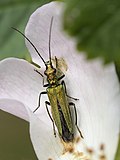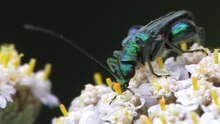Green longhorn beetle
| Green longhorn beetle | ||||||||||||
|---|---|---|---|---|---|---|---|---|---|---|---|---|

Male green longhorn beetle ( Oedemera nobilis ) |
||||||||||||
| Systematics | ||||||||||||
|
||||||||||||
| Scientific name | ||||||||||||
| Oedemera nobilis | ||||||||||||
| ( Scopoli , 1763) |
The green longhorn beetle ( Oedemera nobilis ), also known as the blue-green thigh beetle , is a beetle from the family of the horned beetle (Oedemeridae).
The green of the similar looking species Greenish oedemeridae ( Oedemera lurida ) Gray Green legs Beetle ( Oedemera virescens ) and Gelbbeiniger oedemeridae ( Oedemera flavipes ) is considerably darker.
features
The green horned beetle has a length of around 10 millimeters, in descriptions one finds sizes of 8 to 15 millimeters. The antennae are about as long as the body. Its soft body cover is shiny green, depending on the incidence of light, with a metallic effect. The pronotum is as long as it is wide. The upper wings , which have longitudinal ribs, decrease in size starting from the pronotum and gape apart in the direction of the abdomen, so that the lower wings are not completely covered. In the male beetles, the hind legs are very thickened, in the female these thickenings are absent. However, the strong thickening does not affect the ability to fly. Because of the club-shaped thickening, one of the names used in the Oedemeridae family, thigh beetles, is often used for the species of green horned beetle.
Occurrence
The range of the green horned beetle extends over southern and western Europe with the exception of Ireland and the high Alps. It is more common in southern Europe than north of the Alps. In spring and summer, the beetles can be found on flowers that can be found in meadows, on hedges, in gardens and on the edges of forests.
Way of life
Green longhorn beetles are diurnal and feed on bee pollen and occasionally nectar . New food sources are sought out on the fly. The larvae are found as endophytes in plant stems , for example in dead herbs, rotten wood and sunflower stems . The larva grows in summer and pupates in a pupa cradle in the ground in autumn. Although the beetle is fully developed in autumn, it hibernates in the pupa cradle to hatch in the following spring.
literature
- Wolfgang Dierl: Which Beetle is that? 2nd edition, revised and updated by Martin Baehr, Kosmos Verlag, Stuttgart 2001, ISBN 3-440-08955-X . P. 94.
- Wolfgang Willner: Pocket dictionary of the beetles of Central Europe. Quelle & Meyer Verlag, Wiebelsheim 2013, ISBN 978-3-494-01451-7 , p. 302.
Web links
Individual evidence
- ↑ Entry in Faune Europaea (English)



